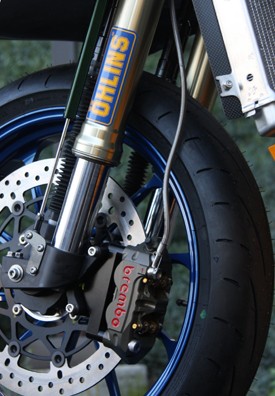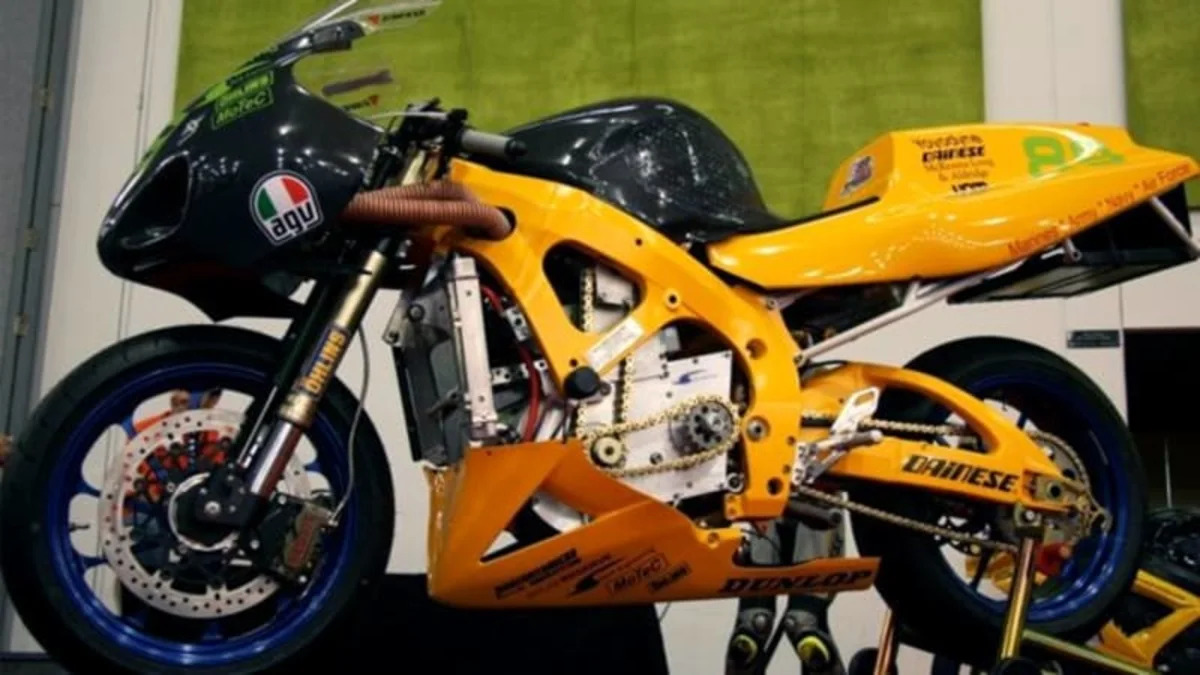Swigz Pro Racing superbike with KERS – Click above to watch the video after the jump
Chip Yates hasn't yet run a single race with his new Swigz superbike but he's confident that when he does, the KERS – the kinetic energy recovery system – will make it a competition-shattering machine. While other electric motorcycles with AC motors may have regenerative braking, theirs is tied only to the back wheel. There's a lot more energy to recoup from the front wheels of a vehicle because that is where most of the braking force is generated. The system Chip's team has created works with the front wheel and he's been kind enough to explain to us (almost) exactly how it works. It's ingenious.
 But before we get into that, we should say a bit more about what they think the KERS will do for their performance. To put it simply, they may have as much as twice the power of current bikes. Were they to run their bike without the system, they would have to restrict output to about 69 horse power in order to reserve enough juice to last a 25 lap race. With KERS engaged, they can conserve enough energy to accelerate with most of the force the 194 hp bike can send to the rear wheel. To put it another way, they reckon they could have a 10-second advantage over lap times done by electrics at Laguna Seca this year.
But before we get into that, we should say a bit more about what they think the KERS will do for their performance. To put it simply, they may have as much as twice the power of current bikes. Were they to run their bike without the system, they would have to restrict output to about 69 horse power in order to reserve enough juice to last a 25 lap race. With KERS engaged, they can conserve enough energy to accelerate with most of the force the 194 hp bike can send to the rear wheel. To put it another way, they reckon they could have a 10-second advantage over lap times done by electrics at Laguna Seca this year.
The short explanation of their set up is this: There are one-way clutches inside the front wheel hub that gather the braking forces and transmits them to twin counter-rotating shafts that run perpendicular alongside the shocks. This spinning energy is sent to sprockets and chains inside the triple clamp. From there, the force spins counter-rotating inner and outer shafts up to the steering head. Those are linked to two counter-rotating bevel gears in the head that connect to
For a more complete explanation (yes, there's more), hit the jump for Chip's own explanation of the system as well as a bonus video they put together for the bike's recent unveiling. We look forward to seeing what this monster can do on a track.
[Source: SWIGZ.COM Pro Racing]
The video meant to be presented here is no longer available. Sorry for the inconvenience.
Swigz Pro Racing KERS explained:
Our pending patents cover several designs of front wheel KERS systems. One of our mechanical KERS systems that we revealed at The Battery Show works by capturing the energy from the front wheel to use for electrical regeneration by our main UQM Powerphase 145 motor, which is normally busy driving the rear wheel. We can discuss the elements of the system that can be seen in the photos but there are certain hidden details including our KERS software that still can't be elaborated on. We can say that the process of electrical regeneration is initiated when the rider squeezes the KERS brake lever, located on the left handlebar. This level sends a signal to our MOTEC ECU, which runs a number of calculations from our KERS control software, and then outputs a regeneration command to the UQM motor controller. The UQM controller then initiates regenerative braking torque in the motor by creating an electromagnetic field in front of the spinning rotor that acts to slow the motor down and feels like front wheel braking.
The front wheel is equipped with special one-way clutches housed in custom CNC machined wheel hubs that allow the front tire to transmit energy back to the electric motor, but do not allow the electric motor to drive the front wheel; our bike is rear-wheel drive only. These clutches have the capability of transmitting more than 500 ft/lbs of braking torque from the front wheel, although we currently software limit the regeneration levels to less than that amount based on a number of factors. The clutches mate to a ring and pinion gear set located on each side of the wheel, on the front axle centerline. The pinion gears turn two counter-rotating and telescoping driveshafts that can be seen running along the outside of the Ohlins front forks.
The driveshafts share the torque load and so can be smaller diameter than if we only used one big shaft. They enter into the lower triple clamp and each has its own sprocket at the top end to drive a chain inside the hollow triple clamp. The two chains coming from either side are positioned one above the other to avoid interference and they drive an inner and outer shaft in the center of the triple clamp that rotate in opposite directions as they head up to the custom steering head in the frame of the bike. Once inside the steering head, one of the shafts turns a lower bevel gear and the shaft rotating the other direction turns an upper bevel gear. Between these counter-rotating bevel gears is an output bevel gear that exits the steering head and turns a KERS driveshaft that runs inside the frame rail of the bike. The counter-rotating driveshafts and bevel gears act to counteract torque steer felt through the handlebars.
The KERS driveshaft runs from the steering head down to a KERS gearbox located inside the frame rail around the area of the rider's knee. The gearbox turns the spinning KERS driveshaft into a rotating drive sprocket, and the sprocket turns a KERS chain that runs down to the UQM electric motor shaft where it can be used to generate electricity for recharging our on-board battery pack. There are a few additional elements to this system that we can't elaborate on for confidentiality reasons but this gives a pretty clear picture how things work.
Our proprietary and patent-pending KERS control software has features that smooth out the front wheel braking, limit braking based on factors such as lean angle for safety and also based on battery pack voltage to guard against overvoltaging the pack. Our MoTeC ECU processes over 150 channels of streaming data from our UQM motor, motor controller and chassis sensors over our two on-board CAN networks running at 1Gbps and many of these channels are used to optimize the KERS system.
Our system can be coupled to the hydraulic front brake for seamless control and activation, but for our testing and first races, we have decided to split the front braking controls into a left handlebar KERS brake lever, and a right handlebar hydraulic friction brake lever to give me more control over how I trail brake into corners.
With this system on our bike at a representative track such as Laguna Seca, we can use the same size battery pack as our electric competitors, but make about twice the horsepower over the course of an entire 12-lap race. Our analysis indicates a lap-time approximately 10 seconds per lap faster than the fastest electric racebikes have recently accomplished at Laguna Seca making it a worthwhile development.



Sign in to post
Please sign in to leave a comment.
Continue